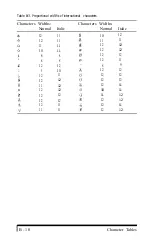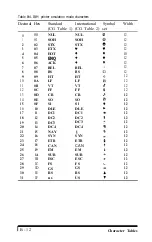
The data dump on the previous page was made while writing an
earlier version of this appendix. By comparing the column of characters
at the right with the printout of hex codes, you can see that the capital
A (for Appendix) in the third row, was printed as 41. You can use the
table of character codes (Appendix B) to find out what character
corresponds to each code.
If you look at the first character of the dump, you can see that the
ESC character appears in hex as 1B, and in the character column as a
dot. To find the command, look at the next character, 40 hex (@), and
refer to the numerical list of commands in Appendix A.
In this way you can quickly determine that prior to printing, the
word processor sent seven commands to set up the printer followed by
a BEL character to sound the beeper.
Command
Function
ESC @
ESC R 0
ESC t 1
ESC 6
DC2
ESC P
ESC p 0
BEL
Initialize printer
Select USA character set
Select Epson Character Graphics
Printable code expansion
Cancel condensed mode
Select pica
Cancel proportional
Sound beeper
If you find codes in your data dump that you did not enter in your
program or codes you did not expect your application program to send,
your computer may be changing the codes before sending them to the
printer.
Data dump mode can be turned off by turning off the printer; it is
also cancelled by an INIT signal from the computer.
IBM PC BASIC Solutions
IBM PC BASIC inserts a carriage return and line feed (CR-LF) after
each 80 characters you send it. It also adds a line feed to each carriage
return included explicitly in an LPRINT statement. Use the BASIC
statement WIDTH LPRINT 255 to remove this problem. The 255 is a
special number that prevents the computer system from inserting a
CR-LF into the line unless there is one in your program.
C - 4
Problem Solving and Maintenance
















































